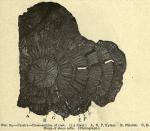 The dry root of Chondoden'dron tomento'sum Ruiz et. Pavon. With not more than 5 per cent. of stem bases.
The dry root of Chondoden'dron tomento'sum Ruiz et. Pavon. With not more than 5 per cent. of stem bases.
BOTANICAL CHARACTERISTICS.—A vine with twining stem 4 inches in diameter; leaves large, cordate, long-petioled, with entire margins; flowers dioecious; fruit purplish, ovoid, 1-seeded, drupaceous, forming thick clusters resembling bunches of grapes.
HABITAT.—Brazil.
DESCRIPTION OF DRUG.—A long, branching, woody root, found in commerce in tortuous, subcylindrical pieces, about 100 to 150 mm. (4 to 6 in.) long, and from 20 to 100 mm. (⅘ to 4 in.) thick. Externally it varies from brown to light grayish-brown in color, and is marked with fissures, transverse ridges, and longitudinal wrinkles. When cut or sliced it displays a dark brown interior, leaving under the knife a waxy luster. A cross-section displays a thin bark; within this bark circle there are two or more circles (zones) of radiating wood-wedges. About 12 of these wood-wedges are found in the central zone radiating from a common center. The outer circles (zones) of wood-wedges are separated from one another by a narrow line of parenchyma, stone cells, and compressed cells, and the short, circular, radiating wedges of wood are separated from one another by medullary tissue, making a combination of concentric and radiate arrangement which is quite characteristic. Sometimes sections of the stem are found in the drug; these have a rather thick bark and a narrow pith. Taste at first mild, then bitter and somewhat acrid; odorless.
Powder.—Brownish-yellow. Characteristic elements: Starch, ellipsoidal, simple or 2 to 4 compound (7 to 15 µ in diam.); sclerenchyma consisting of long bast fibers and numerous isodiametric or elongated stone cells 20 to 50 µ across; wood fibers, simple or bordered pits; cork, dark brown cells (20 to 25 µ in diam.); calcium oxalate, in rosettes, few.
CONSTITUENTS.—Pelosine (cissampeline), amorphous, insoluble in hot or cold water, soluble in alcohol and chloroform; starch, gum, tannin; taste sweetish-bitter.
Preparation of Pelosine (also known as Cissampeline).—Boil root in acidulated H2SO4 water, precipitate with K2CO3, purify by redissolving in acidulated water, decolorize with charcoal, again precipitate with K2CO3 and purify from solution in ether.
ACTION AND USES.—As a remedial agent pareira is generally conceded to be beneficial as a diuretic and tonic in the treatment of cystitis and suppurative kidney diseases, acting in a soothing manner, especially on the bladder. Formerly renowned as a lithontriptic. Dose: 30 to 60 gr, (2 to 4 Gm.). Fluidextractum Pareirae, U.S.P. 1900 Dose: ½ to 2 fluiddrams (2 to 8 mils).

